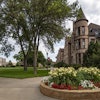California’s Minority Enrollment Is Up , But That’s Only Part of the Story
BERKELEY, Calif. — The number of Black and Hispanic freshmen admitted to the University of California system has rebounded to the level it was when race and gender preferences were still in place.
However, much of the recovery is because more Blacks and Hispanics are being admitted to lesser-known UC campuses. The flagship Berkeley campus is still well below 1997 totals, as is the prestigious Los Angeles campus.
University officials say that 7,336 Black, Hispanic and American Indian students have been admitted for the fall semester, 100 more than were admitted for fall 1997 — the last year admissions officers were allowed to take race and gender into account.
Regent Bill Bagley, who opposed dropping affirmative action, says he was pleased by the enrollment increases, but “it is still a fact that the flagship campuses of Berkeley and UCLA are being seriously deprived of diversity.”
Regent Ward Connerly, who wrote the new race-blind policies and has become a national figure in the anti-affirmative action movement, credits the recovering Black and Hispanic admissions to new outreach efforts.
Those include aggressive recruiting, a guarantee that the top 4 percent of graduates in each high school will get a place provided they meet eligibility requirements and greater emphasis on evaluating how each applicant may have overcome adversity such as poverty or bad schools.
The reported increases prompted a statement from national affirmative-action opponents who say the figures confirm that the abolition of affirmative action programs do not lead to an increase in diversity.
“We are pleased to see that the numbers are rebounding in the absence of preferences,” says Steve Balch, president of the National Association of Scholars, in a statement. “Preferences are indefensible in any case, and these numbers just drive another nail in their coffin.”
Thomas Wood, executive director of the California Association of Scholars, added in the statement: “Clearly, [Proposition] 209 is not an exclusionary measure, either in its face and application, or in its effect.”
Yet Black, Hispanic and American Indian students have not regained their proportional standing: They accounted for 18.8 percent of new freshmen admissions in 1997 and 17.6 percent of offers this fall.
There was also a significant difference between Black and Hispanic admissions. The number of Black students admitted to the system’s eight undergraduate campuses is still 7 percent below 1997 levels, 1,328 vs. 1,435. Hispanic admissions went up 5 percent, from 5,494 to 5,753.
“There is a certain satisfaction of where we are at this time, but clearly we realize and appreciate that there’s still a lot more to do,” says university spokesman Terry Lightfoot.
Officials say it is impossible to estimate how much of the increase in Hispanic admissions is due to boosted outreach efforts and how much to the simple fact that the Hispanic presence in the state is growing.
Meanwhile, the Daily Californian is reporting that affirmative-action advocates are currently circulating petitions for two separate ballot initiatives to reinstate race and gender preferences in the state.
The paper says that Ron Rodriguez, the official proponent of a constitutional amendment to repeal Proposition 209, was cleared to begin collecting signatures until the end of June. He needs more than 670,000 signatures to place the proposition on the November ballot.
© Copyright 2005 by DiverseEducation.com


















